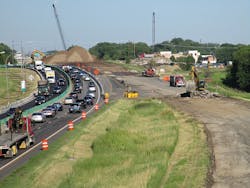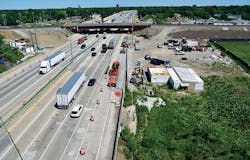Recommended practices for the installation and removal of lane closures on multilane highways
By: Juan M. Morales, P.E.
We all have seen lane closures.
They are often a necessity for construction and maintenance operations, and may result in reduced capacity, inconvenience to drivers, and highway worker exposure. Workers are often in close proximity to traffic, sometimes unprotected. Lane closures affect the mobility of traffic and the safety of both the traveling public and highway workers. Because of these and other reasons, it is imperative that lane closures are properly evaluated, designed, installed, and removed.
Since traffic never stops, how are these lane closures installed and removed? Do standards exist? What are some of the recommended practices available?
Part 6 of the Manual on Uniform Traffic Control Devices (MUTCD), 2009 Edition, is the current source of temporary traffic control (TTC) standards and guidelines in the U.S. The standards contained in the MUTCD are applicable to all public roads regardless of type, class, or agency having jurisdiction in accordance with Title 23 of the U.S. Code, and Highways Safety Program Standard 13, “Traffic Engineering Services.” During temporary (or non-permanent) conditions, such as lane closures, traffic is particularly dependent on design, placement, and uniformity of traffic control devices to direct and guide it safely and efficiently through what would otherwise be hazardous areas.
Having said that, the MUTCD does not include any standards or even guidelines regarding installation and removal of lane closures. Why not? One of the reasons for this apparent oversight is that, when it comes to lane closures, there are too many variables to consider, thus making developing standards and guidelines somewhat difficult. Variables such as the type of road (e.g., multilane vs. two-lane), the number of lanes, the speed of traffic, the volume of traffic, the time of day (day vs. night), the duration of the work, sight distance, the number of workers available, the type of work, and the location of the site (urban vs. rural) would play a role in determining how to install and remove lane closures safely. The MUTCD concedes that “[this] Manual describes the application of traffic control devices, but shall not be a legal requirement for their installation.” The MUTCD leaves the installation and removal of lane closures to recommended practices and “engineering judgment,” which the MUTCD defines as “the evaluation of available pertinent information, and the application of appropriate principles, provisions, and practices as contained in this Manual and other sources, for the purpose of deciding upon the applicability, design, operation, or installation of a traffic control device.”
Some recommended practices do exist. Some states have developed step-by-step procedures to install and remove lane closures. For instance, the Virginia Department of Transportation’s (VDOT) Work Area Protection Manual (WAPM) includes a section (6G-25) on “Installing/Removing Temporary Traffic Control,” which provides guidelines for installing and removing lane closures. It should be stated that, within the context of the MUTCD and the WAPM, a “standard” statement is a mandatory statement, while a “guidance” statement is a statement of recommended, but not mandatory, practice.
The American Traffic Safety Services Association (ATSSA) also discusses recommended practices for the installation and removal of lane closures on multilane highways in its Traffic Control Technician (TCT) certification course and accompanying temporary traffic control guide. This course (or a state-specific variation) is either accepted or required in several states.
Both VDOT and ATSSA recommend that lane closures of multilane highways (more than one lane in each direction) be installed with the flow of traffic, in the following sequence:
- Install all advance warning signs, beginning with the ROAD WORK AHEAD (W20-1) sign and ending with the END ROAD WORK (G20-2 (V)) sign. Install all signs beginning with the opposite side which will be closed; for a right lane closure, first, install all signs on the left side (shoulder) and then install all signs on the right side (shoulder).
- Install shoulder taper if required.
- Install arrow board on the shoulder prior to the merging taper or as close to the beginning of the merging taper as possible.
- Install channelizing devices to form a merging taper. Use of a shadow vehicle (with or without a truck-mounted attenuator [TMA], depending on the type of roadway) is recommended during installation.
- Install traffic control devices along the buffer space.
- Continue placing devices along the work space at the appropriate spacing.
- Install devices for the termination area. Install an END ROAD WORK sign, if necessary.
- Review the lane closure by performing a drive-thru inspection, correcting any deficiencies and documenting necessary adjustments.
Three important clarifications are needed. First, VDOT requires shadow vehicles for this operation, which is technically considered a mobile operation. In the Commonwealth of Virginia, the shadow vehicle shall (standard) be equipped with a TMA if the speed is 45 mph or above. The application of TMAs is optional in the MUTCD. Because of that, TMAs are not common in those states that adopted the MUTCD without a state supplement. The application of TMAs to protect (i.e., to “shadow”) workers during installation and removal of lane closures on high-speed multilane highways is highly recommended and may even be required in your state. Notice that the TMA is not the work vehicle but rather a second vehicle that “shadows” the work vehicle and the workers. These vehicles are normally equipped with flashing arrows, changeable message signs, and/or high-intensity rotating, flashing, oscillating, or strobe lights located properly in advance of the workers and/or equipment that they are protecting. These shadow vehicles might themselves cause injuries to occupants of the errant vehicles if they are not equipped with TMAs. TTC devices should not be stored, installed, or removed from a shadow vehicle or a shadow vehicle with a TMA. These devices should be stored, installed, or removed from a work operation vehicle. If a TMA is used, it should be used in accordance with the manufacturer’s instructions considering matters such as the recommended roll-ahead distance and the weight of the host vehicle.
Second, workers running across high-speed traffic lanes to install or remove TTC devices is a dangerous practice that should not be performed. This practice is strongly discouraged. To install advance warning signs from the left side (for instance, the median), workers should utilize a TMA as a shadow vehicle to install signs on the “open” lane first, then loop around (by making a U-turn) in the work vehicle to the shoulder of the soon-to-be “closed” lane. The Occupational Safety and Health Administration (OSHA) issued a directive in 2012 entitled “Inspection and Citation Guidance for Roadway and Highway Construction Work Zones,” which used “crossing live lanes of high-speed traffic” (“exposure to the hazard of being struck by public traffic or construction vehicles and equipment”) as an example of imminent danger conditions where an OSHA citation may be appropriate.
Third, the use of police is recommended during installation and removal of lane closures on high-speed multilane highways. The presence of police officers may deter speeding and help draw attention to the work activity. It should be stated the safety of police officers themselves is important and that officers should be trained in work zone safety procedures. Police officers should meet with project personnel in advance to discuss when, where, and how their services will be used. If possible, the use of a trooper, placed on the shoulder at a reasonable and safe distance (approximately 500 to 800 ft in advance of the vehicles performing the lane closure operations), is recommended to increase driver awareness and slow approaching traffic. The trooper’s vehicle should not block an open lane unless protected by a TMA.
To remove the lane closure and reopen the lane(s), the process is reversed. All TTC devices for a stationary lane closure on a multilane roadway should be removed against the flow of traffic in the following sequence:
- Remove the channelizing devices starting from the end of the activity area working back to the widest part of the merging taper.
- Place the removal vehicle on the shoulder, and remove the channelizing devices from the merging taper by hand onto the work vehicle.
- Remove the arrow board.
Depending on the situation and applying engineering judgment, advance warning signs may be removed either with the flow of traffic or against the flow of traffic. VDOT’s WAPM states that “Advance warning signs should be removed with the flow of traffic beginning with the ROAD WORK AHEAD sign and ending with the END ROAD WORK sign.” The reasoning is to avoid vehicles backing on shoulders open to public travel. “Remove signs beginning with the lane closure side (for a right lane closure: first, remove all signs from the right side (shoulder) and then remove all signs left side (shoulder).” It also states that “when traffic delays have exceeded expectations, a worker on each shoulder may disassemble the advance warning signs and their portable sign support in reverse order to allow delayed traffic to clear. The disassembled signs and their supports may be stored beyond the shoulder until such time as traffic delays have dispersed and signs can be removed safely.”
Do not let the lack of specific standards hinder the safety of workers and the traveling public while installing and removing lane closures on high-speed multilane highways. If we train all workers, follow the recommended practices discussed above, and apply solid engineering judgment, installation and removal of lane closures can be accomplished in a way that is safe and efficient for both workers and the traveling public.
-----------------------
NOTE: The views expressed in this article are the author’s own and may not represent the views of VDOT, ATSSA, OSHA, or any other agency/organization.
About The Author: Morales is President of J.M. Morales & Associates P.C., an Orlando consulting firm specializing in traffic safety.





